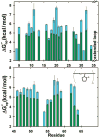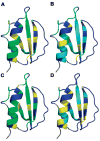Residue-level interrogation of macromolecular crowding effects on protein stability
- PMID: 18459780
- PMCID: PMC2435214
- DOI: 10.1021/ja8005995
Residue-level interrogation of macromolecular crowding effects on protein stability
Abstract
Theory predicts that macromolecular crowding affects protein behavior, but experimental confirmation is scant. Herein, we report the first residue-level interrogation of the effects of macromolecular crowding on protein stability. We observe up to a 100-fold increase in the stability, as measured by the equilibrium constant for folding, for the globular protein chymotrypsin inhibitor 2 (CI2) in concentrations of the cosolute poly(vinylpyrrolidone) (PVP) that mimic the protein concentration in cells. We show that the increased stability is caused by the polymeric nature of PVP and that the degree of stabilization depends on both the location of the individual residue in the protein structure and the PVP concentration. Our data reinforce the assertion that macromolecular crowding stabilizes the protein by destabilizing its unfolded states.
Figures





Similar articles
-
Volume exclusion and soft interaction effects on protein stability under crowded conditions.Biochemistry. 2010 Aug 24;49(33):6984-91. doi: 10.1021/bi100727y. Biochemistry. 2010. PMID: 20672856 Free PMC article.
-
Polymer crowders and protein crowders act similarly on protein folding stability.FEBS Lett. 2013 Mar 1;587(5):394-7. doi: 10.1016/j.febslet.2013.01.030. Epub 2013 Jan 23. FEBS Lett. 2013. PMID: 23353683 Free PMC article.
-
Differential dynamical effects of macromolecular crowding on an intrinsically disordered protein and a globular protein: implications for in-cell NMR spectroscopy.J Am Chem Soc. 2008 May 21;130(20):6310-1. doi: 10.1021/ja801020z. Epub 2008 Apr 18. J Am Chem Soc. 2008. PMID: 18419123 Free PMC article.
-
Folding of circular and permuted chymotrypsin inhibitor 2: retention of the folding nucleus.Biochemistry. 1998 Jun 2;37(22):8139-46. doi: 10.1021/bi980250g. Biochemistry. 1998. PMID: 9609709
-
Models of macromolecular crowding effects and the need for quantitative comparisons with experiment.Curr Opin Struct Biol. 2010 Apr;20(2):196-206. doi: 10.1016/j.sbi.2010.01.008. Epub 2010 Feb 16. Curr Opin Struct Biol. 2010. PMID: 20167475 Free PMC article. Review.
Cited by
-
Macromolecular crowding remodels the energy landscape of a protein by favoring a more compact unfolded state.J Am Chem Soc. 2010 Aug 4;132(30):10445-52. doi: 10.1021/ja103166y. J Am Chem Soc. 2010. PMID: 20662522 Free PMC article.
-
Effects of proteins on protein diffusion.J Am Chem Soc. 2010 Jul 14;132(27):9392-7. doi: 10.1021/ja102296k. J Am Chem Soc. 2010. PMID: 20560582 Free PMC article.
-
Minimal effects of macromolecular crowding on an intrinsically disordered protein: a small-angle neutron scattering study.Biophys J. 2014 Feb 18;106(4):905-14. doi: 10.1016/j.bpj.2013.12.003. Biophys J. 2014. PMID: 24559993 Free PMC article.
-
An expanding arsenal of experimental methods yields an explosion of insights into protein folding mechanisms.Nat Struct Mol Biol. 2009 Jun;16(6):582-8. doi: 10.1038/nsmb.1592. Nat Struct Mol Biol. 2009. PMID: 19491935 Review.
-
Remodeling of the Conformational Dynamics of Noncanonical DNA Structures by Monomeric and Aggregated α-Synuclein.J Am Chem Soc. 2020 Oct 28;142(43):18299-18303. doi: 10.1021/jacs.0c07192. Epub 2020 Oct 19. J Am Chem Soc. 2020. PMID: 33075229 Free PMC article.
References
Publication types
MeSH terms
Substances
Grants and funding
LinkOut - more resources
Full Text Sources
Other Literature Sources

